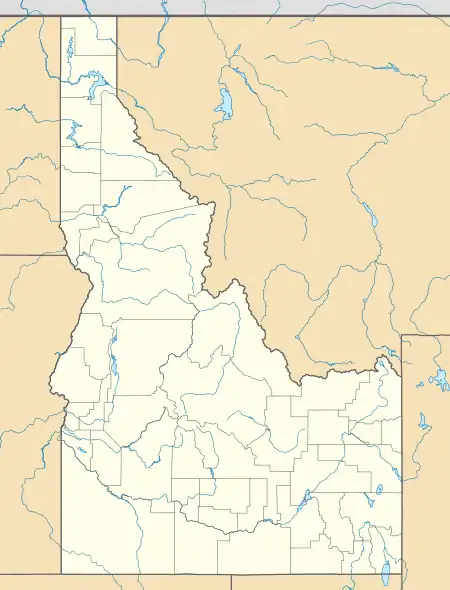H. K. Fritchman House
The H.K. Fritchman House in Boise, Idaho, was a 1+1⁄2-story Colonial Revival cottage designed by Tourtellotte & Co. and constructed in 1904. The house featured an off center, pedimented porch with Doric columns, decorative window head moldings under side gables, and a prominent, pedimented front gable with dimple window centered below the lateral ridgebeam. The house was added to the National Register of Historic Places (NRHP) in 1982.[2] The house either was demolished or moved after its listing on the NRHP, and further research is needed.
H. K. Fritchman House | |
.jpg.webp) The H.K. Fritchman House in 1980 | |
  | |
| Location | 1207 W. Hays St., Boise, Idaho |
|---|---|
| Coordinates | 43°37′25″N 116°12′09″W |
| Area | less than one acre |
| Built | 1904 |
| Architect | Tourtellotte,John E. & Company |
| Architectural style | Colonial, Shingled Colonial |
| MPS | Tourtellotte and Hummel Architecture TR |
| NRHP reference No. | 82000202[1] |
| Added to NRHP | November 17, 1982 |
Harry Fritchman was a commercial traveler or traveling salesman based in Boise. He lived briefly in Portland, Oregon, then returned to Boise in 1904, the year the H.K. Fritchman House was constructed.[3] Fritchman served one year as mayor of Boise 1911–1912.[4]
A second H.K. Fritchman House was constructed at 1707 Harrison Boulevard in 1920, and it is a contributing resource in Boise's Harrison Boulevard Historic District. At the time of his death, Harry Fritchman was living two blocks from the second house, at 1606 N. 17th St.[5]
See also
References
- "National Register Information System". National Register of Historic Places. National Park Service. November 2, 2013.
- "National Register of Historic Places Inventory/Nomination: H. K. Fritchman House". National Park Service. Retrieved April 7, 2019. With accompanying pictures
- "New Buildings". Idaho Statesman. Boise, Idaho. March 20, 1904. p. 7.
- "Boise Civic Leaders Eulogize Former Mayor H.K. Fritchman". Idaho Statesman. Boise, Idaho. June 1, 1942. p. 10.
- "Harry Fritchman Dies Unexpectedly at Home". Idaho Statesman. Boise, Idaho. June 1, 1942. p. 1.